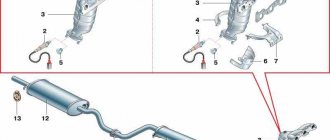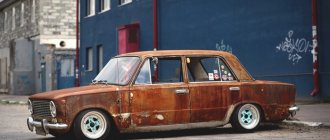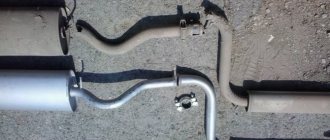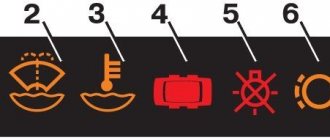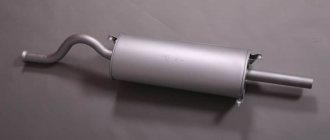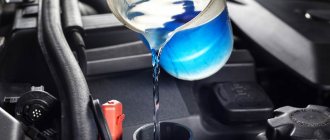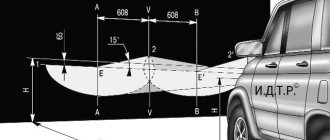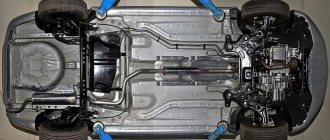Can mufflers be painted?
The car muffler, just like the resonator, as well as other components of the exhaust system, are exposed to aggressive environments. All this seriously affects their service life, so a completely reasonable question arises: how to protect the muffler and is it possible to paint the muffler? There are options for mufflers that already have a protective coating in the form of a layer of aluminum or a layer of zinc, not to mention expensive spare parts made of stainless steel. There is no particular point in applying paint to them, but it is quite possible to protect parts made of ordinary black steel.
Among the aggressive influences, the most powerful are:
- temperature changes, especially in winter;
- changes in humidity and the presence of moisture in the exhaust;
- salts and reagents that melt ice and snow on roads in winter; they destroy car exhaust parts;
- minor mechanical damage (from small stones, debris, etc.);
If you paint a car muffler against these factors, you can temporarily protect the exhaust system.
How to protect the muffler from corrosion?
To get a more or less effective option for exhaust protection, you should correctly determine what to paint the car muffler with. To do this, you should take high-quality heat-resistant paint. The temperature of the muffler may be more than 100 C, and the temperature of the collector may be more than 600-700 C. If you paint not only the muffler, then this must be taken into account! By the way, this is the paint that mufflers are painted at some manufacturing plants.
The choice of what paint to use is yours, since there are many options on the market and many manufacturers for how to paint a car muffler.
And so, before painting the muffler you should:
- thoroughly clean the surface of the muffler, you can “sandblast”;
- treat the muffler with a rust converter;
- wash off the rust converter with water or carefully remove it with a rag;
- degrease with solvent (an important point);
- prime;
- paint the muffler, while applying heat-resistant paint, preferably from a spray bottle, to minimize smudges.
If you don’t have a spray bottle, you can paint the muffler with a regular brush, if you do it carefully.
Rusted again: what needs to be done with the muffler so that there is no corrosion in it
Receive one of the most read articles by email once a day. Join us on Facebook and VKontakte.
First of all, one simple truth should be emphasized: a car muffler is not at all the thing on which you should save. It is better to refrain from purchasing equipment made from ordinary iron. Such mufflers quickly burn out and rot. It is better to immediately purchase products made from high-quality heat-resistant alloy steel. However, this may not be enough to protect the unit from corrosion.
Eliminating car corrosion
Metal corrosion, or more simply put, rust, is the oxidation of iron due to contact with water. The bottom of the car is especially susceptible to corrosion, almost in no way protected from moisture, but, nevertheless, suffering from dampness no less than the body.
More cars die from rust than in accidents
Based on the nature of corrosion formation in a car, the following types are distinguished:
- Contact. Occurs in places where metals come into contact with different electrode potentials;
- Electrolyte;
- Non-electrolyte corrosion occurs in fuel and oil systems;
- Gas is formed in the muffler or exhaust pipe;
- Atmospheric - due to the interaction of the machine with the environment;
- Under voltage;
- Structural is formed in places where metals are welded;
- Biocorrosion is formed by the action of microorganisms, in particular mold.
- Crevice occurs in the gaps and joints of car parts.
Corrosion also differs in the degree of damage:
- Pinpointing occurs in places where the paint layer is damaged; it occupies a small area on the surface, but affects the metal in depth.
- Spots. Appears on bare metal, acts on the surface, and does not deepen at the initial stage.
- Through - extreme degree of corrosion, holes in the metal indicate that the metal in this place is completely destroyed.
Where does corrosion occur?
Corrosion can appear in any part of the car body
Intensive corrosion of the car body begins from below. Rust prefers to appear on parts of the body exposed to paint, in areas that most often come into contact with moisture. These are the bottom, spoilers, wings, etc. Risk areas are considered to be
- Places where the body borders the lights and radiator grille.
- Hood and trunk roof (door);
- Attachment points for handles and locks;
- Bottom edge of the door;
- welding places.
The underbody of the car, which bears the maximum load, requires close attention. All power units are concentrated under it, and therefore the bottom experiences the aggression of chemical agents and temperature changes.
Outside - impacts from pebbles and crushed stone, ice build-ups in winter, tall grass or tough low bushes in summer - these factors tear off the protective layer of anti-corrosion, exposing the metal of the bottom to the destructive effects of moisture and dirt.
Anti-icing chemicals containing salts and acids pose an increased danger to vehicles. To protect your car from rust, you need to eliminate the causes of metal corrosion.
How to protect your car from corrosion?
Puttying, priming and painting the body are carried out, first of all, to protect the car from rust. The paint coating prevents contact of the metal with the external environment. And only then is it an element of beauty and design.
But even the most professional painting is not able to protect the car from rust if the permanent place of residence is the street: an open parking lot, or a yard. In such conditions, even the paintwork wears out much faster than when the car is placed in a garage overnight - an enclosed space with ventilation and, if possible, heating. In addition to the conditions for storing the car, some measures are taken to increase resistance to corrosion.
After all, the thickness of the metal of the car body is less than 1 mm. And if you do not provide protection from moisture and corrosion, within a year, the rust will eat through the body of the car. The car becomes especially vulnerable to destruction in winter.
Measures to protect the underbody of a car from rust
Not only the body, but also the underbody of the car is susceptible to corrosion.
The underbody of the car is more susceptible to rust than other elements of the car, and therefore requires increased special protection. This service is provided by professional car services that process the metal of the bottom not only from the outside, but also from the inside, using special sprayers.
Anti-corrosion protective coatings for cars are divided into
- passive, forming a protective layer (film) on the metal surface that prevents moisture from entering. This group of anti-corrosion substances contains resins, bitumen, mastics, rubber, and is applied in a thin layer of no more than 2 mm.
- Transformative, or active protection against metal rust, differs in that it converts rust into a stable compound that prevents further rust from spreading. The most popular substance that protects against oxidation is Movil, which is sold in every car store.
Anti-corrosion protection agents for the bottom are produced in liquid and viscous consistencies.
- Liquid products are sprayed and penetrate into closed, hard-to-reach cavities. They use long hose attachments that penetrate hard-to-reach areas of the bottom.
- Viscous products only cover visible and accessible areas because they are applied with a brush.
Before applying anti-corrosion protective coatings to metal, it must be washed from soil and dirt, dried and degreased . At the car dealership, the car is lifted on a lift, the wheels are removed to avoid anticorrosive getting on them, and the brake discs are wrapped in polyethylene.
Preparing for the painting process
During preparatory work, special attention should be paid to cleaning the paint from old enamel. Neglecting advice may result in poor quality painting. It is especially important to completely remove all traces of corrosion and rust.
There are several options for removing such plaques:
- You can use a very stiff brush with high-quality wire bristles to clean the surface. If there is an area of pinpoint damage from destructive corrosion on the surface, it is worth treating it with epoxy putty;
- A conventional scraper can provide relatively good results. This device is used in the process of preparing various parts for the painting process. If you are processing a relief surface, you should use special shaped scrapers. To significantly speed up the process, it is recommended to use a special grinding machine;
- If it is necessary to remove a layer of old paint from the muffler, effective chemical removers can be used. They are ideal for cleaning surfaces from various water-borne paints, as well as organic compounds;
An ordinary heat gun is perfect for high-quality cleaning of a car muffler, but it must be used very carefully. As soon as the paint swells and peels, it must be carefully removed.
This method is not suitable for parts that are made from materials that contain large amounts of lead, since during the heating process the latter can begin to evaporate quickly, which is very dangerous for the health of the person who is carrying out the painting process.
Muffler painting instructions
Before painting a car muffler, to prevent the assembly from rusting, you must thoroughly clean the surface of the old coating. This is a mandatory stage on which the strength and reliability of the subsequent coating, effective protection against corrosion and wear depend. When painting the most important part of the exhaust system, special attention should be paid to the quality of its cleaning from rust, dirt and old coating. The heat-resistant composition ideally fits only on a well-prepared surface.
Preparation
For cleaning you can use: - a stiff brush with wire bristles; — chemical removers; — figured scraper; - heat gun. When using a brush with stiff wire bristles, rust can often be found under a layer of paint and dirt, the area of which must be additionally treated with epoxy putty. Chemical strippers can be used before applying heat-resistant (heat-resistant) spray paint to the muffler. These active substances are excellent for cleaning the surface of a part from old organic or water-soluble paints. They are applied in a thick, dense layer to the part. To do this, use a brush with natural bristles. Then the paint is removed using a spatula or wooden spatula. After this, the surface should be wiped dry with a clean rag or napkins. A shaped scraper is used when preparing an exhaust system element for painting. It's convenient to use. To achieve a perfectly smooth surface, it is necessary to sand using medium-grain sandpaper or a special machine. Heat-resistant spray paint for the muffler adheres well to a surface that has been cleaned of the old enamel layer using a heat gun. This tool must be used with extreme caution, observing fire safety regulations. To do this, it is recommended to place a piece of damp cloth under the part during heat treatment.
Important! A heat gun cannot be used if it is made with a large amount of lead. This chemical element evaporates when heated, so it can be harmful to health.
Painting
If you have already decided on how to paint the car muffler so that it does not rust, you can start painting. This stage has its own difficulties. During the process of painting the muffler, smudges often form. They can worsen the performance characteristics of the unit and do not look aesthetically pleasing at all. To prevent the formation of sagging, you must adhere to a simple technology: - the enamel must be applied in thin layers, each time after complete drying; — the spray gun should be held at the same distance from the surface; — do not move the sprayer at an angle or in an arc; — the sprayed substance should capture not only the edges of the part, but also extend beyond its boundaries; — each strip must be applied evenly to the previous painted areas.
Pay attention to: Car varnish aerosol: main types, advantages and application technique
Heat treatment
After coating, the surface needs additional heat treatment. The easiest way to do this is with a hair dryer. In order for a truly heat-resistant coating to form during the drying process, it is necessary to periodically pass hot air through the part in both directions. Some experts also advise pre-heating the outer part of the exhaust manifold. However, some motorists believe that this stage is not mandatory. According to them, the muffler heats up during the operation of the equipment, so it does not require additional calcination.


